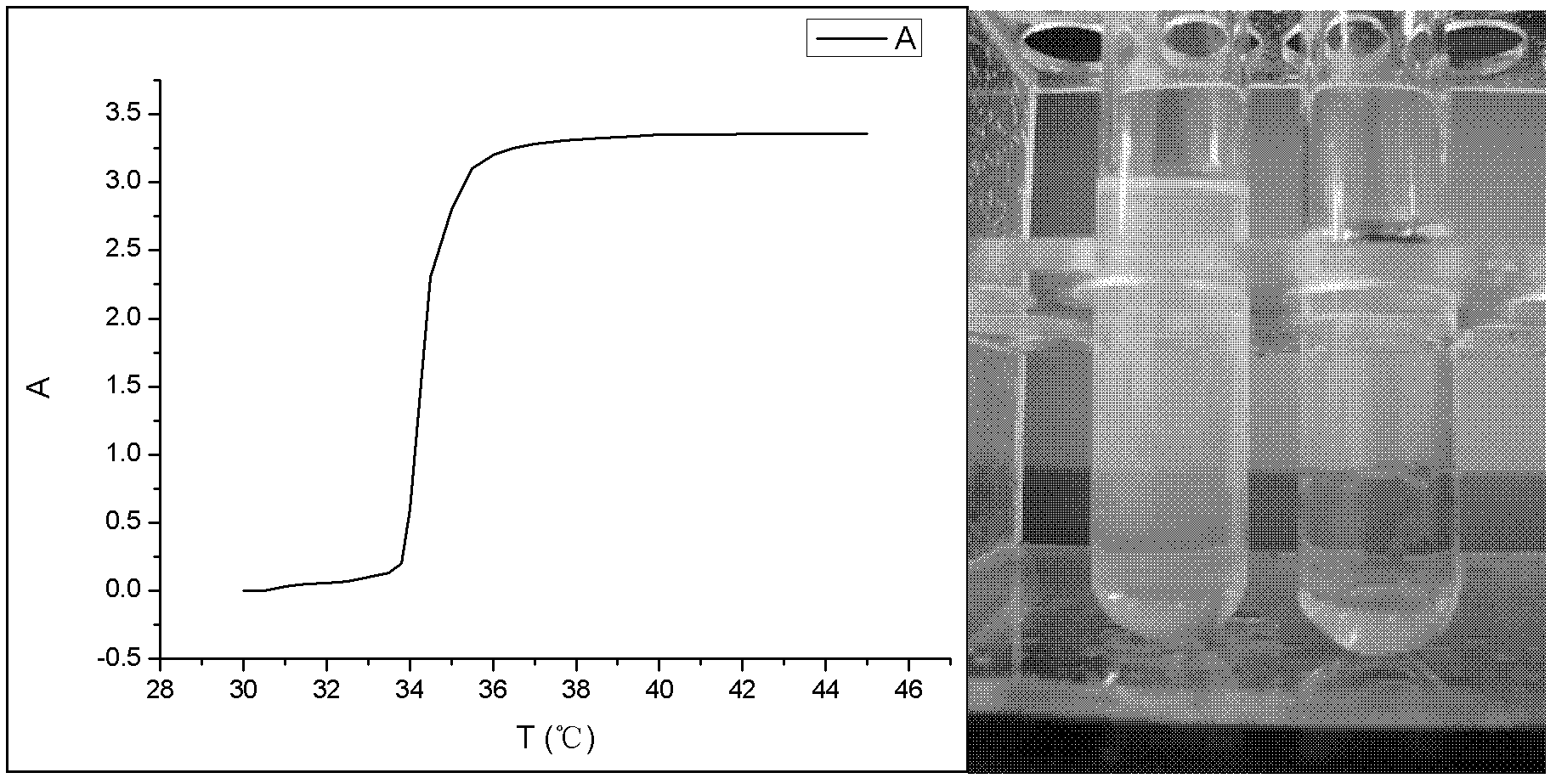Dual-hydrophilic thermo-sensitive polymer/lactic acid polymer composite nanofiber felt and preparation method thereof
A technology of composite nanofibers and lactic acid polymers, applied in spinning solution preparation, textile and papermaking, non-woven fabrics and other directions, can solve the problems of industrialization difficulties, complex preparation process of stimuli-responsive polymers, and high experimental conditions, and achieve synthesis The effect of simple route, low price and rich source
- Summary
- Abstract
- Description
- Claims
- Application Information
AI Technical Summary
Problems solved by technology
Method used
Image
Examples
Embodiment 1
[0037] Add 3.96g of N-isopropylacrylamide, 2.34g of glucose divinyl adipate and 0.126g of AIBN into a flask equipped with a magnetic stirring rotor and an adapter, completely dissolve in 5mL of DMF, seal it, and repeatedly evacuate it. After several times of nitrogen, the reaction system was placed at 60°C under the protection of nitrogen and stirred for 24 hours. After that, the viscous colorless and transparent polymer solution obtained from the reaction was precipitated in a large amount of ether, and the ether was poured out, and the white solid precipitate was again Dissolve in a small amount of ethanol, repeatedly precipitate and dissolve until all unreacted monomers are washed out, and dry in a vacuum oven at 37°C for 24 hours to obtain a white solid powder.
[0038] Dissolve 0.2 g of the obtained white solid powder in 1 mL of pure alcohol, stir it magnetically for 4 h, and degas it by ultrasonication for 5 min.
[0039] Dissolve 0.2 g of poly(lactic acid-glycolic acid)...
Embodiment 2
[0042] Add 3.96g of N-isopropylacrylamide, 2.34g of glucose divinyl adipate and 0.126g of AIBN into a flask equipped with a magnetic stirring rotor and an adapter, completely dissolve in 5mL of DMF, seal it, and repeatedly evacuate it. After several times of nitrogen, the reaction system was placed at 60°C under the protection of nitrogen and stirred for 24 hours. After that, the viscous colorless and transparent polymer solution obtained from the reaction was precipitated in a large amount of ether, and the ether was poured out, and the white solid precipitate was again Dissolve in a small amount of ethanol, repeatedly precipitate and dissolve until all unreacted monomers are washed out, and dry in a vacuum oven at 37°C for 24 hours to obtain a white solid powder.
[0043] 0.4 g of the obtained white solid powder was dissolved in 1 mL of a mixed solution of alcohol and water with a volume ratio of 1:1, magnetically stirred for 3 h, and ultrasonically degassed for 4 min.
[00...
Embodiment 3
[0047] Add 3.96g of N-isopropylacrylamide, 2.34g of dextrose divinyl adipate and 0.126g of AIBN into a flask equipped with a magnetic stirring rotor and an adapter, completely dissolve in 5mL of DMF, seal it, and repeatedly evacuate it. After several times of nitrogen gas, the reaction system was placed at 60°C and stirred for 24 hours under the protection of nitrogen gas, and then the viscous colorless and transparent polymer solution obtained from the reaction was precipitated in a large amount of ether, and the ether was poured out, and the white solid precipitate was again Dissolve in a small amount of ethanol, repeatedly precipitate and dissolve until all unreacted monomers are washed out, and dry in a vacuum oven at 37°C for 24 hours to obtain a white solid powder.
[0048] 0.4 g of the obtained white solid powder was dissolved in 2 mL of a mixed solution of alcohol and water with a volume ratio of 1:1, magnetically stirred for 3 h, and ultrasonically degassed for 4 min. ...
PUM
 Login to View More
Login to View More Abstract
Description
Claims
Application Information
 Login to View More
Login to View More - R&D
- Intellectual Property
- Life Sciences
- Materials
- Tech Scout
- Unparalleled Data Quality
- Higher Quality Content
- 60% Fewer Hallucinations
Browse by: Latest US Patents, China's latest patents, Technical Efficacy Thesaurus, Application Domain, Technology Topic, Popular Technical Reports.
© 2025 PatSnap. All rights reserved.Legal|Privacy policy|Modern Slavery Act Transparency Statement|Sitemap|About US| Contact US: help@patsnap.com



